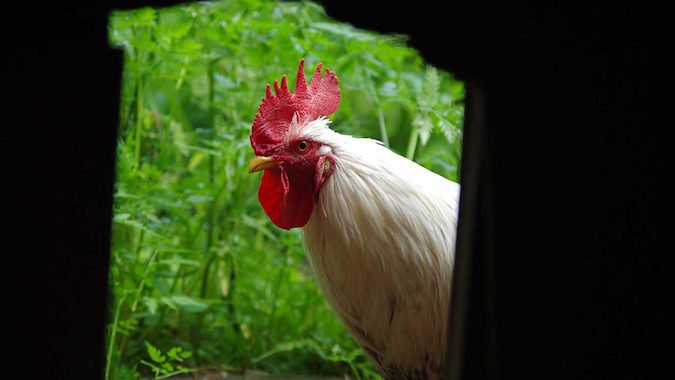Scientists Condemn Researcher's Use of CRISPR to Produce HIV-Resistant Babies
While attitudes toward CRISPR embryo editing remain mixed, the general consensus amongst experts is that He Jiankui’s actions present a tremendous ethical breach on a variety of levels.

CRISPR-Cas9 is a tool that lets scientists cut and insert small pieces of DNA at precise areas along a DNA strand. | Image Credit: Ernesto del Aguila III, National Human Genome Research Institute, NIH
Editor’s Note: This article was originally published in an edition of NOVA’s email newsletter, NOVA Lens, and has now been repurposed for NOVA Next. Sign up for NOVA Lens here (select “NOVA Newsletters”).
This week has been a wild ride for scientists studying genome editing technologies—and perhaps for the human race at large.
It began on Sunday, when a scientist named He Jiankui (who has been on leave from the Southern University of Science and Technology in Shenzhen, China since February) announced in a short YouTube video that he’d taken what nearly all scientists perceive to be a drastic, premature, and highly unethical step: He and his team of collaborators had eliminated a gene called CCR5 in the DNA of human embryos, transferred those twin embryos into their mother’s uterus, and allowed the mother to carry her pregnancy to term and produce two live births. The scientists used a powerful tool called CRISPR-Cas9, which is cheap and easy to use, to modify the embryos’ genomes with the express goal of creating human children resistant to HIV infection (watch two explainer videos about CRISPR here and here).
If confirmed, this would not be the first time a scientist had edited a human embryo. In April 2015, Chinese scientists altered a non-viable human embryo using CRISPR-Cas9, and in February 2016, a major scientific institution in London received the green light from the U.K. Human Fertilization and Embryology Authority (HFEA) to use it on healthy human embryos. But this is the first reported example of gene editing that has resulted in a live birth (and another is allegedly in progress).
The announcement, which came before any evidence of publication or peer-review, blasted through the scientific community and the public eye just two days before the start of the International Human Genome Editing Summit at the University of Hong Kong. At the summit on Wednesday, He gave a 20-minute talk defending his achievement before an audience of critical and outraged scientists. While attitudes toward CRISPR embryo editing remain mixed, the general consensus amongst experts is that He’s actions present a tremendous ethical breach on a variety of levels—most notably because he used a modified, viable embryo to create a human being without the full engagement of independent scientists, ethicists, regulators, or institutional review boards.
“The fact that a CRISPR-edited embryo was allowed to initiate a pregnancy that turned into two live births is ethically appalling,” said Harvard University’s David Liu, who was at the summit in Hong Kong this week. “It’s hard to believe that so many ethical missteps actually took place that enabled such an event to happen.”
CRISPR-Cas9 is a gene-editing tool derived from an ancient bacterial immune system, CRISPR. This system’s function in bacteria is to identify the DNA of invading viruses and send in a specific type of enzyme, like Cas9, to target and “cut” a piece of DNA. Researchers realized that Cas9 could easily be artificially manipulated to recognize almost any sequence of DNA and cut it out. After the DNA is cut, DNA bases (A, T, C, or G) can be added to or removed from the genome. Since each amino acid—or building block of a protein—originates from a sequence of three bases, adding or deleting a couple of bases can significantly affect the protein produced. In many cases, adding one or two bases to a gene will result in a nonfunctional protein.
In the case of the twins, who were dubbed the pseudonyms “Lulu” and “Nana,” the researchers targeted CCR5, a gene that provides the blueprint for a cell surface protein involved in immune function. While the protein is normally involved in relaying information between cells, HIV can use it to dock onto cells and infect them with its own genetic material. A small subset of the human population has a mutated version of CCR5, called ∆32, which yields a shorter version of the protein. People with two copies of this mutation are resistant to certain strains of HIV. He and his researchers may have been attempting to imitate the effect of this mutation by disrupting CCR5 via CRISPR-Cas9.
Because CRISPR-Cas9 induces mutations in a way that researchers cannot directly control, He and his colleagues were not able to exactly replicate the ∆32 mutation on a genetic level. Rather, they disrupted the CCR5 gene to create what Liu called a “mixture of disrupted gene products,” or nonfunctional versions of CCR5 that have different genetic alterations.
Since the researchers have not released any information on the specifics of the DNA they targeted, Liu says, “it’s difficult to speculate exactly what those products are.”
“That fact raises an additional degree of concern that it’s possible that the disrupted form of the CCR5 they generated is a different thing than the CCR5 ∆32 variant that occurs naturally,” Liu said. The ∆32 mutation has been conserved across generations, and is not known to have any negative impact on health. On the other hand, CCR5 variants generated via CRISPR-Cas9 could potentially have a negative affect on human health.
CRISPR-Cas9 technology can also introduce unwanted mutations in the form of off-target effects that occur when Cas9 cuts in another, unintended location. Researchers in the genome-editing field conduct off-target analyses to characterize and minimize off-target effects in their experiments, but procedures for these analyses are still being refined and agreed upon by the genome editing community. He and his group have not released the details of any such analysis, and it remains unclear whether they investigated off-target effects to the high standard required for human research.
Also concerning is the fact that He modified germ cells as opposed to somatic cells. The former are sexually reproductive cells (like embryonic cells) that pass any edits on to future generations; that is, if Lulu or Nana eventually procreate, the edits they received as embryos will carry on inside the genomes of their offspring. “The ethical issues raised by embryo editing are quite distinct from, and more complicated, more extensive than those required for considering somatic cell editing,” Liu said.
The Southern University of Science and Technology has condemned He’s work, as have many academic and medical institutions around the world. The Chinese government itself put a stop to the research on Thursday.
“The fact that the researcher’s institution is distancing itself from the work is deeply troubling because we rely on all of those parties—independent scientists, ethicists, institutional review panels, and governing bodies—to ensure that the health and well-being of patients is protected,” Liu said. (There are other red flags, too—including the fact that participants were given a consent form that falsely stated that the project was an AIDS vaccine trial.)
Dana Waring, education director and co-founder of pgEd, the Personal Genetics Education Project, echoed Liu’s focus on the infants themselves, as well as the need to explore alternative angles to problems like HIV rates and the stigma associated with disease.
“This is a tool that needs to be used judiciously,” Waring said. “The first question I asked myself was, ‘What else is happening around HIV treatment prevention?’” In China, HIV-phobia runs rampant and He himself cited HIV stigma as his primary motivation in going forward with the experiment.
“It’s an enormous risk for these children,” she said, adding that she dislikes the trending hashtag #CRISPRbabies. “These are human lives that are going to need a lot of enormous care and attention.”
Care for human life and this project’s impact on future therapy development drive Liu’s and the rest of the scientific community’s worries. “If we really want to maximize the effectiveness and the efficiency with which we bring these new potential therapeutic strategies to patients, we have to progress in a thoughtful and well-coordinated manner,” Liu said. He’s neglect of the genome editing community’s research principles, Liu added, “risks delaying or denying these potentially transformative therapies to the many other people that urgently need them.”



